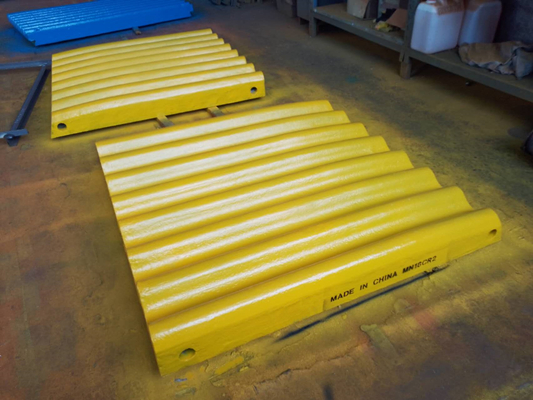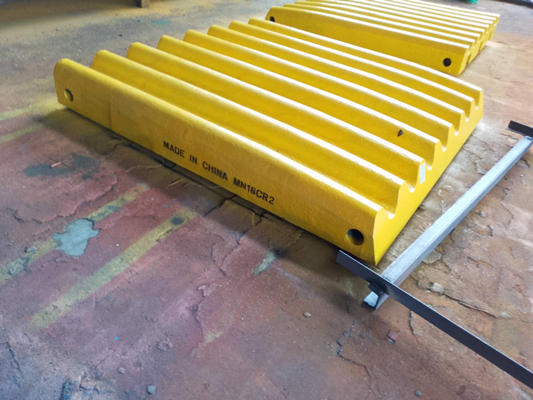In the process of operation, jaw plate is often worn, which affects the normal performance of jaw crusher. This paper studies the low-carbon alloy steel material of jaw crusher, and discusses the change law of jaw plate hardness and wear resistance, so as to determine the quenching temperature when jaw plate wear resistance reaches a good level.
Selection of jaw material
1. In manufacturing, the movable jaw plate and fixed jaw plate are made of wear-resistant high manganese steel, the main bearing liner and eccentric bearing liner are made of cast babbitt alloy, and the jaw plate is made of cast iron to improve its durability. The jaw plate of jaw crusher needs to be in service under wear-resistant, impact-resistant and high-toughness conditions. Different manufacturers use different jaw plate materials, such as high manganese steel, medium manganese steel, alloy cast iron, medium carbon low alloy wear-resistant steel and high chromium cast iron.
2. Medium-carbon low-alloy wear-resistant steel is obtained by adding a variety of alloy elements such as Cr, Si, Mn, Mo, V on the basis of medium-carbon steel, and the total alloy content is less than 5%. This kind of medium-carbon low-alloy wear-resistant steel can properly adjust different carbon content and alloy element content, so it can be matched with different heat treatment processes to obtain different mechanical properties, so it has attracted more attention and application. In this paper, the wear resistance of medium carbon low alloy ZG42Mn2Si1REB was studied, and the change law of hardness and wear resistance with quenching temperature was discussed, and a better heat treatment process was obtained.
The choice of heat treatment process
According to the characteristics of ZG42Mn2Si1REB steel, the martensite structure obtained after quenching has higher hardness and better wear resistance. Three temperature points of 870℃, 900℃ and 930℃ are selected for heat treatment, and the tempering temperature is uniformly fixed at 230℃. Because the material does not contain Mo element, in order to ensure the hardenability, 5% Nacl solution is used for cooling.
Results and analysis
1. Influence of quenching temperature on hardness and wear resistance
The hardness of samples quenched at different temperatures was measured by HR-150A Rockwell hardness meter, measuring 5 points each time and then taking the average value. It was found that with the increase of quenching temperature, the quenching hardness first increased and then decreased. When the quenching temperature is 870℃, the hardness is HRC53. When the quenching temperature rises to 900℃, the hardness also rises to HRC55. It can be seen that the hardness increases with the increase of temperature; When the temperature continues to increase to 930℃, the hardness decreases to HRC54, and it can be found that the hardness is higher when quenched at 900℃. Therefore, with the increase of temperature, the wear weight loss decreases. When the temperature continues to rise to 930℃, the wear weight loss increases to 3.5mg. It can be seen that when quenched at 900℃, its hardness is high and the wear weight loss is lacking. The medium carbon low alloy wear-resistant steel ZG42Mn2Si1REB has good wear resistance, which also shows that the process at this time is the correct heat treatment process.
2. Comparison of wear resistance between medium carbon low alloy and high manganese steel
To illustrate the superior wear resistance of medium carbon alloy steel ZG42Mn2Si1REB, this material is compared with high manganese steel ZGMn13. Among them, ZG42Mn2Si1REB was tested according to the above-mentioned technological conditions of quenching at 900℃ and tempering at 230℃, and high manganese steel ZGMn13 was treated with water toughening. The experimental results show that the wear resistance of the former is 1.5 times that of the latter, which indicates that the jaw plate of medium carbon low alloy steel has fully exerted the potential of the material and has excellent wear resistance under proper heat treatment conditions.
As far as the material cost is concerned, high manganese steel contains up to 13% Mn, so it needs to consume a lot of alloy elements. Compared with high manganese steel, medium carbon low alloy steel ZG42Mn2Si1REB contains only 3%~4% alloy elements, and does not contain high-priced Cr and Mo elements, so it has a high price competitive advantage. In addition, considering the heat treatment process, the medium carbon low alloy steel is quenched at 900℃ and tempered at 230℃, while the water toughening treatment of high manganese steel often exceeds 1000℃, so the quenching temperature of the former is lower, the heating time is shorter, and the energy saving effect is more remarkable. The better heat treatment process was applied to the jaw plate of crusher, which obviously improved the wear resistance, and the replacement cycle of jaw plate was extended from 150d to 225d, with obvious economic benefits.
Through the research on the wear resistance of the jaw plate of medium carbon low alloy steel of jaw crusher, the results show that when quenched at 900℃, the microstructure after quenching is martensite, at this time, the hardness is higher, the wear weight loss is lower, and the wear resistance is better.
Shanvim as a global supplier of crusher wearing parts, we manufacture cone crusher wearing parts for different brands of crushers. We have more than 20 years of history in the field of CRUSHER WEAR PARTS. Since 2010, we have exported to America, Europe, Africa and other countries in the world.
Post time: Sep-23-2022



